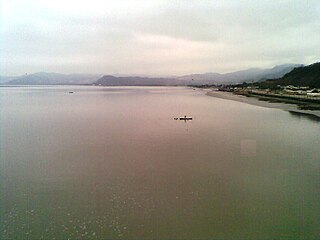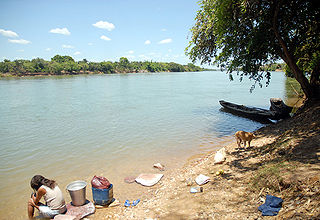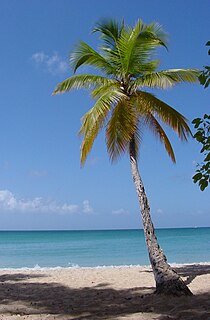
The Orinoco Delta is a vast river delta of the Orinoco River, located in eastern Venezuela.

Guaraqueçaba Ecological Station is an ecological station in the municipality of Guaraqueçaba, Paraná, Brazil.

The Bahia Mangroves is a tropical ecoregion of the Mangrove forests Biome, and the South American Atlantic Forest biome, located in Northeastern Brazil.
The Central African mangroves ecoregion consists of the largest area of mangrove swamp in Africa, located on the coasts of West Africa, mainly in Nigeria.

The Guinean mangroves are a coastal ecoregion of mangrove swamps in rivers and estuaries near the ocean of West Africa from Senegal to Sierra Leone.

Madagascar mangroves are a coastal ecoregion in the mangrove forest biome found on the west coast of Madagascar. They are included in the WWF's Global 200 list of most outstanding ecoregions.
The Southern Africa mangroves are an ecoregion of mangrove swamps in rivers and estuaries on the eastern coast of South Africa.

The Gurupi-Piriá Marine Extractive Reserve is a coastal marine extractive reserve in the state of Pará, Brazil.

The Marajó várzea (NT0138) is an ecoregion of seasonally and tidally flooded várzea forest in the Amazon biome. It covers a region of sedimentary islands and floodplains at the mouth of the Amazon that is flooded twice daily as the ocean tides push the river waters onto the land. The flooded forests provide food for a wide variety of fruit-eating fish, aquatic mammals, birds and other fauna. It has no protected areas and is threatened by cattle and water-buffalo ranching, logging and fruit plantations.

The Tocantins-Araguaia-Maranhão moist forests (NT0170), also called the Tocantins/Pindaré moist forests, is an ecoregion in the north of Brazil to the south of the mouth of the Amazon River. It is part of the Amazon biome. The ecoregion contains the city of Belém, capital of the state of Pará. It is the most developed part of the Amazon region, and is one of the most severely degraded natural habitats of the region.

The Amazon-Orinoco-Southern Caribbean mangroves (NT1401) is an ecoregion along the coasts of Colombia, Venezuela, Guyana, Suriname, French Guiana and Brazil.

The Pará mangroves (NT1427) is an ecoregion along the Atlantic coast of the state of Pará in Brazil. They constitute the western extension of the Maranhão mangroves ecoregion. The mangroves are relatively intact, although they are under some pressure from agriculture and logging.

The South American Pacific mangroves (NT1405), or Panama Bight mangroves, is an ecoregion along the Pacific coast of Panama, Colombia, Ecuador and Peru.

The Gulf of Panama mangroves (NT1414) is an ecoregion along the Pacific coast of Panama, Colombia. The mangroves experience seasonal flooding with high levels of sediment, and occasional extreme storms or very low rainfall due to El Niño effects. They are important as a breeding or nursery area for marine species. Areas of the mangroves have been recognized as Important Bird Areas and Ramsar wetlands. The ecoregion has been severely degraded by clearance of mangroves for agriculture, pasturage and shrimp farming, by urban pressure around Panama City, and by pollution related to the Panama Canal.

The Esmeraldas-Pacific Colombia mangroves (NT1409) is an ecoregion of mangrove forests along the Pacific coast of Colombia and Ecuador. It is threatened by human population growth, leading to over-exploitation for wood and clearance for farming and aquaculture.

The Manabí mangroves (NT1418) is an ecoregion along the Pacific coast of Ecuador. The mangroves serve important functions in the marine and terrestrial ecology. They have been severely degraded and fragmented, particularly in the northern region. Construction of shrimp farms caused much damage in the past, but is now banned. Sedimentation caused by overgrazing in higher lands is an issue, as are human activities such as port and highway construction, urbanization, waste disposal and so on.

























